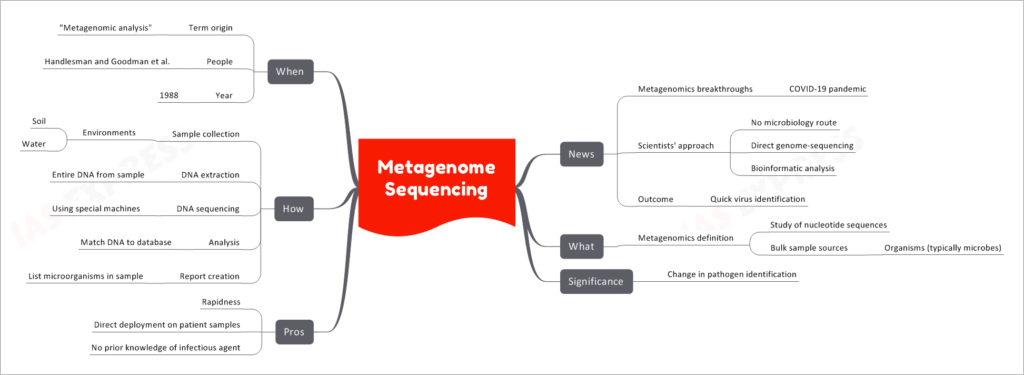Metagenome sequencing

In recent news, metagenome sequencing has achieved groundbreaking advances in the realm of genomics, offering significant contributions to various scientific fields. This powerful approach has notably influenced our understanding of microbiology, pathogen identification, and even played a pivotal role in addressing challenges posed by the COVID-19 pandemic.
This topic of “Metagenome sequencing” is important from the perspective of the UPSC IAS Examination, which falls under General Studies Portion.
Metagenomics Breakthroughs: Shaping Responses to the COVID-19 Pandemic
COVID-19 Pandemic and Metagenomics
The global COVID-19 pandemic highlighted the importance of rapid and accurate virus identification. Metagenomics emerged as a key player in this scenario, revolutionizing the way scientists approach pathogen identification.
Scientists’ Approach: A Shift in Microbiology Techniques
No Microbiology Route
Traditionally, identifying microbes required cultivating them in the lab. However, metagenomics introduced a novel approach that does not rely on cultivating individual microbes.
Direct Genome Sequencing
Metagenomics leverages direct genome sequencing from complex samples, bypassing the need for isolating and growing individual microorganisms.
Bioinformatic Analysis
The collected genetic data undergoes sophisticated bioinformatic analysis, enabling researchers to decipher the complex genetic makeup of mixed microbial communities.
Outcome: Swift Virus Identification
This innovative approach has led to a rapid and efficient identification of viruses, including the SARS-CoV-2 virus responsible for COVID-19. By directly sequencing genetic material from patient samples, metagenomics enables timely virus detection.
What is Metagenomics: Unlocking Genomic Insights from Diverse Samples
Metagenomics Definition
Metagenomics is the study of nucleotide sequences present in bulk samples obtained from various sources, predominantly organisms, especially microbes inhabiting diverse environments.
Bulk Sample Sources
These bulk samples can include various types of organisms, particularly microbes, that reside in different environments, from soil to water bodies.
Significance: Revolutionizing Pathogen Identification
Metagenomics has triggered a profound change in the field of pathogen identification, offering a new perspective on understanding microbial communities and their potential role in diseases.
Pros of Metagenome Sequencing: Transforming Genetic Analysis
Rapidity in Analysis
Metagenome sequencing significantly accelerates the process of identifying microorganisms, allowing for swift response in situations like disease outbreaks.
Direct Deployment on Patient Samples
The ability to directly sequence genetic material from patient samples facilitates prompt diagnosis and enables tailored treatment strategies.
No Prior Knowledge of Infectious Agent Required
Metagenomics doesn’t require prior knowledge of the infectious agent, making it particularly useful when dealing with novel pathogens or complex microbial communities.
How Metagenome Sequencing Works: From Sample Collection to Analysis
Sample Collection
Metagenomics involves collecting samples from diverse environments, ranging from soil to water bodies, to capture a wide range of microbial diversity.
Environments
- Soil: Sample collection from soil environments reveals the genetic diversity of microorganisms residing in the earth’s crust.
- Water: Water samples unveil the hidden genetic information of microbes inhabiting aquatic ecosystems.
DNA Extraction
The collected samples undergo DNA extraction, where the entire DNA present in the sample is isolated for further analysis.
DNA Sequencing
DNA sequencing is performed using specialized machines that read the genetic code of the extracted DNA, generating vast amounts of genetic data.
Analysis
The generated genetic data is matched against existing genetic databases, helping to identify and characterize the microorganisms present in the sample.
Report Creation
The analysis results are compiled into comprehensive reports that list the microorganisms identified in the sample, shedding light on the microbial community composition.
When and Who: The Origins of Metagenome Sequencing
Term Origin
The term “metagenomic analysis” was coined to describe this revolutionary approach that explores genetic material from complex microbial communities.
Key Contributors
Scientists like Jo Handelsman and Jonathan Goodman, along with their colleagues, were instrumental in laying the foundations of metagenomics.
Year of Emergence
The concept of metagenomics was first introduced in 1988, setting the stage for a paradigm shift in genetic analysis and microbial exploration.

